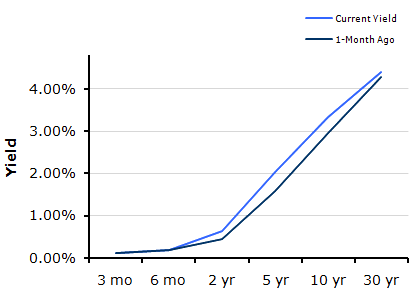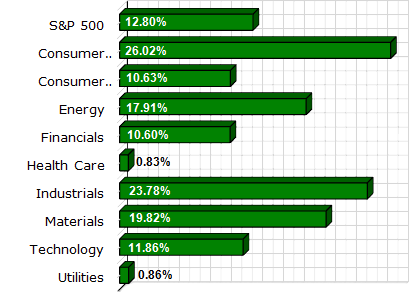
Market Commentary by Scott J. Brown, Ph.D., Chief Economist

It was a relatively quiet week in terms of the economic data. Consumer confidence figures for December disappointed. However, what people say and what they do are two separate things (the soft confidence figure is countered by evidence of increased consumer spending). Evaluations of current job availability remained depressed. Holiday sales were reported as “strong,” but heavy snow buried post-Christmas sales in some areas.
Claims for unemployment insurance benefits fell below 400,000 in the Christmas week, but the figures are suspect due to the seasonal adjustment. Still, the trend in claims has been lower over the last few months – still relatively high by historical standards (we need to see the figure moving below 350,000 to be consistent with a “strong” job market), but moving in the right direction. The December Chicago Purchasing Managers survey and the November Pending Home Sales Index rose more than expected, but failed to have much of an impact on the markets.
Next week, the near year brings fresh (December) data. We could see some market reactions to any surprises in the ISM surveys, but the focus will be on Friday’s job market figures. Fed Chairman Bernanke will testify on “The Economic Outlook and Monetary and Fiscal Policy” at 9:30am on Friday.
The Employment Report is based on two separate surveys. The household survey is a telephone survey of about 60,000 households and generates estimates of the unemployment rate. The establishment survey covers about 400,000 worksites and yields estimates of nonfarm payrolls, average weekly hours, and average hourly earnings. In Friday’s release, the household survey data will be subject to annual benchmark revisions (revisions to the establishment survey will be included in the January Employment Repot, to be released on February 4th).
The household survey revisions are unlikely to alter the recent picture, although unemployment figures for recent months could be revised slightly higher or lower. There will also be some minor methodology revisions, which won’t affect the estimate of the unemployment rate. The lapse in extended unemployment insurance benefits may reduce the unemployment rate in December (as some people will have likely exited the labor force). Nonfarm payrolls should post a moderate gain (around 140,000), but seasonal adjustment is tricky. In addition, we could see revisions to the payroll figures for October and November.
Indices
| Last | Last Week | YTD return % | |
| DJIA | 11569.71 | 11559.49 | 10.95% |
| NASDAQ | 2662.98 | 2671.48 | 17.36% |
| S&P 500 | 1257.88 | 1258.84 | 12.80% |
| MSCI EAFE | 1649.69 | 1644.16 | 4.36% |
| Russell 2000 | 789.74 | 790.59 | 26.28% |
Consumer Money Rates
| Last | 1-year ago | |
| Prime Rate | 3.25 | 3.25 |
| Fed Funds | 0.25 | 0.25 |
| 30-year mortgage | 5.02 | 5.31 |
Currencies
| Last | 1-year ago | |
| Dollars per British Pound | 1.539 | 1.606 |
| Dollars per Euro | 1.326 | 1.434 |
| Japanese Yen per Dollar | 81.740 | 92.380 |
| Canadian Dollars per Dollar | 1.001 | 1.055 |
| Mexican Peso per Dollar | 12.379 | 13.063 |
Commodities
| Last | 1-year ago | |
| Crude Oil | 89.84 | 79.28 |
| Gold | 1405.05 | 1092.35 |
Bond Rates
| Last | 1-month ago | |
| 2-year treasury | 0.63 | 0.46 |
| 10-year treasury | 3.33 | 2.96 |
| 10-year municipal (TEY) | 5.29 | 4.77 |
Treasury Yield Curve – 12/31/2010

S&P Sector Performance (YTD) – 12/31/2010

Economic Calendar
| January 3rd | — | Construction Spending (November) ISM Manufacturing Index (December) |
| January 4th | — | Factory Orders (November) FOMC Meeting Minutes (December 14th) Unit Auto Sales (December) |
| January 5th | — | Challenger Layoff Intentions (December) ADP Payroll Estimate (December) ISM Non-Manufacturing Index (December) |
| January 6th | — | Jobless Claims (week ending January 1st) |
| January 7th | — | Employment Report (December) Bernanke Testimony |
| January 13th | — | Producer Price Index (December) Trade Balance (November) |
| January 14th | — | Consumer Price Index (December) Retail Sales (December) Industrial Production (December) |
| January 17th | — | Martin Luther King, Jr. Holiday (markets closed) |
| January 25th/26th | — | FOMC Meeting |
Important Disclosures
Past performance is not a guarantee of future results. There are special risks involved with global investing related to market and currency fluctuations, economic and political instability, and different financial accounting standards. The above material has been obtained from sources considered reliable, but we do not guarantee that it is accurate or complete. There is no assurance that any trends mentioned will continue in the future. While interest on municipal bonds is generally exempt from federal income tax, it may be subject to the federal alternative minimum tax, state or local taxes. In addition, certain municipal bonds (such as Build America Bonds) are issued without a federal tax exemption, which subjects the related interest income to federal income tax. Investing involves risk and investors may incur a profit or a loss.
US government bonds and treasury bills are guaranteed by the US government and, if held to maturity, offer a fixed rate of return and guaranteed principal value. US government bonds are issued and guaranteed as to the timely payment of principal and interest by the federal government. Treasury bills are certificates reflecting short-term (less than one year) obligations of the US government.
Commodities trading is generally considered speculative because of the significant potential for investment loss. Markets for commodities are likely to be volatile and there may be sharp price fluctuations even during periods when prices overall are rising. Specific sector investing can be subject to different and greater risks than more diversified investments.
Tax Equiv Muni yields (TEY) assume a 35% tax rate on triple-A rated, tax-exempt insured revenue bonds.
![]() Material prepared by Raymond James for use by its financial advisors.
Material prepared by Raymond James for use by its financial advisors.
The information contained herein has been obtained from sources considered reliable, but we do not guarantee that the foregoing material is accurate or complete. Data source: Bloomberg, as of close of business December 30th, 2010.
©2010 Raymond James Financial Services, Inc. member FINRA / SIPC.


